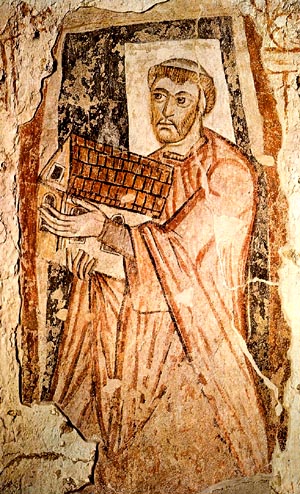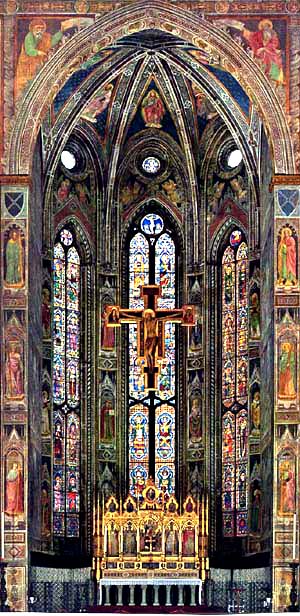 |
The Saint of the Day
St. Benedict Biscop, January 12
Prof. Plinio Corrêa de Oliveira
Biographical selection:
Benedict Biscop was born in 628 into the Northumbrian nobility. He was raised in the court of the King of England. He served King Oswy and distinguished himself, particularly in the use of arms. The King had chosen him as his personal aide-de-camp and he exercised an important role in the war campaigns of this monarch. Benedict received many awards and proofs of esteem for his valor in combat and fidelity to the King.

St. Benedict Biscop helped to Romanize the Catholic Church in England
|
Nonetheless, after a pilgrimage to Rome, Benedict returned to England and asked permission to leave a career of arms and to enter the religious life. He dedicated himself for several years to study and prayer with the idea of promoting on the British Isle the Roman religious art and liturgy of Western Christianity.
Later he entered the Order of St. Benedict and founded numerous monasteries, the most famous being the Monastery of St. Peter at Wearmouth in 674. He also took charge and reformed others where fidelity to the rule had become relaxed. He was a trusted adviser to St. Theodore, the Archbishop of Canterbury, and St. Adrian in their activities in England.
It was St. Benedict Biscop who initiated a great program in architecture and art. He introduced on the English Isle stained glass windows and paintings on the Church walls, as well as Roman music and sacred chant. He sent for architects and artists from Italy to build and decorate the Churches, and liturgists from Rome to train the monks in the common practices. To regularize the religious ceremonies, he wrote a book called On the Celebration of Feasts.
At the end of his life he suffered from a painful paralysis that deprived him the use of his lower limbs and tested his patience greatly. He died in 690.
Comments of Prof. Plinio:
Considering the historical period in which St. Benedict Biscop lived, it is interesting to consider his special mission. He followed that era of saints who founded nations. Those saints who founded nations were replaced or succeeded by saints who embellished those nations. And he was clearly a saint who embellished a nation.

St. Benedict introduced stained glass windows and oil paintings to English Churches - Holy Cross Church, Florence
|
He established the Roman religious styles of art and architecture in England by sending for Italian artists with a true Catholic spirit. He sent for stained glass windows, as well as Mass and music books. He put order in the religious feasts, which at that time were almost the only kind of feasts known. With all this, he introduced elements of beauty into the religious life. Afterward, these elements of beauty would spread from the religious to the temporal sphere. For, in all the movements of the History of Christianity, such embellishments began in the religious life and, afterward, spread to the temporal sphere. For this reason, he was one who “embellished” the England of his time.
This saint, this “embellisher” saint, was not soft, spineless, or lacking in fiber. The embellishment he made had two great elements of inspiration that all adornments need:
First, they reflected the meditation, seriousness, and depth of a contemplative soul who carries out this action of embellishments with great profundity of thought. Such a soul gives beauty a richness of content and expression that makes it not only a thing that pleases the eyes and ears, but also something that speaks to the mind.
Second, he carried out this act of embellishment with something of the spirit of the warrior that he had been. Such warriors are strong, virile men, men who know how to fight and command. It is men like these who give rise to the dawn of the art of a nation. Soft, weak men, fearful in face of the fight, are the ones who produce the eras of decadence in art.
The saints who know how to meditate profoundly and also how to be warriors – these are the ones who give birth to all true artistic development.
This is the lesson we can take from the life of St. Benedict Biscop.


  |
| Prof. Plinio Corrêa de Oliveira |
|
The Saint of the Day features highlights from the lives of saints based on comments made by the late Prof. Plinio Corrêa de Oliveira. Following the example of St. John Bosco who used to make similar talks for the boys of his College, each evening it was Prof. Plinio’s custom to make a short commentary on the lives of the next day’s saint in a meeting for youth in order to encourage them in the practice of virtue and love for the Catholic Church. TIA thought that its readers could profit from these valuable commentaries.
The texts of both the biographical data and the comments come from personal notes taken by Atila S. Guimarães from 1964 to 1995. Given the fact that the source is a personal notebook, it is possible that at times the biographic notes transcribed here will not rigorously follow the original text read by Prof. Plinio. The commentaries have also been adapted and translated for TIA’s site.
|
Saint of the Day | Home | Books | CDs | Search | Contact Us | Donate

© 2002- Tradition in Action, Inc. All Rights Reserved
|
 |
|